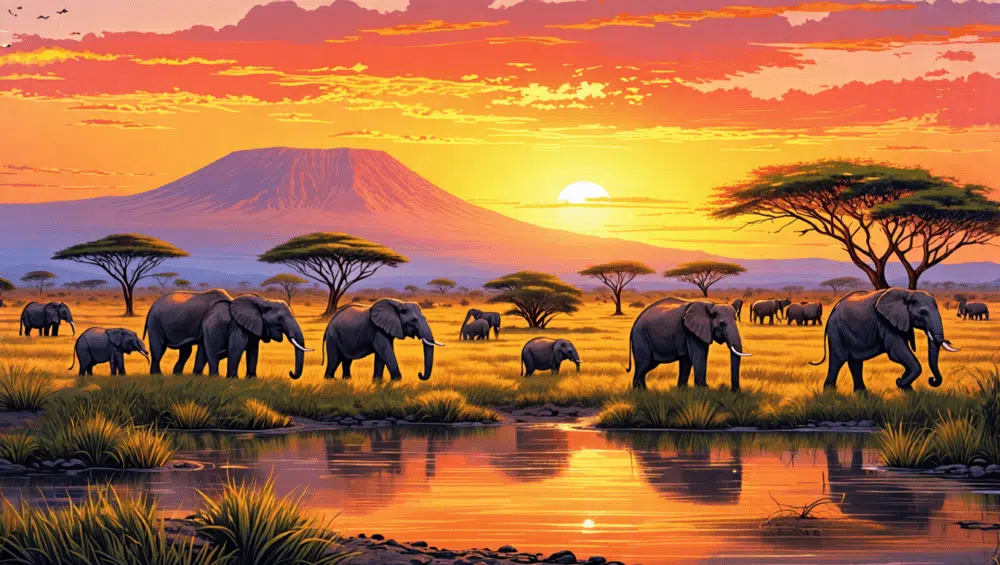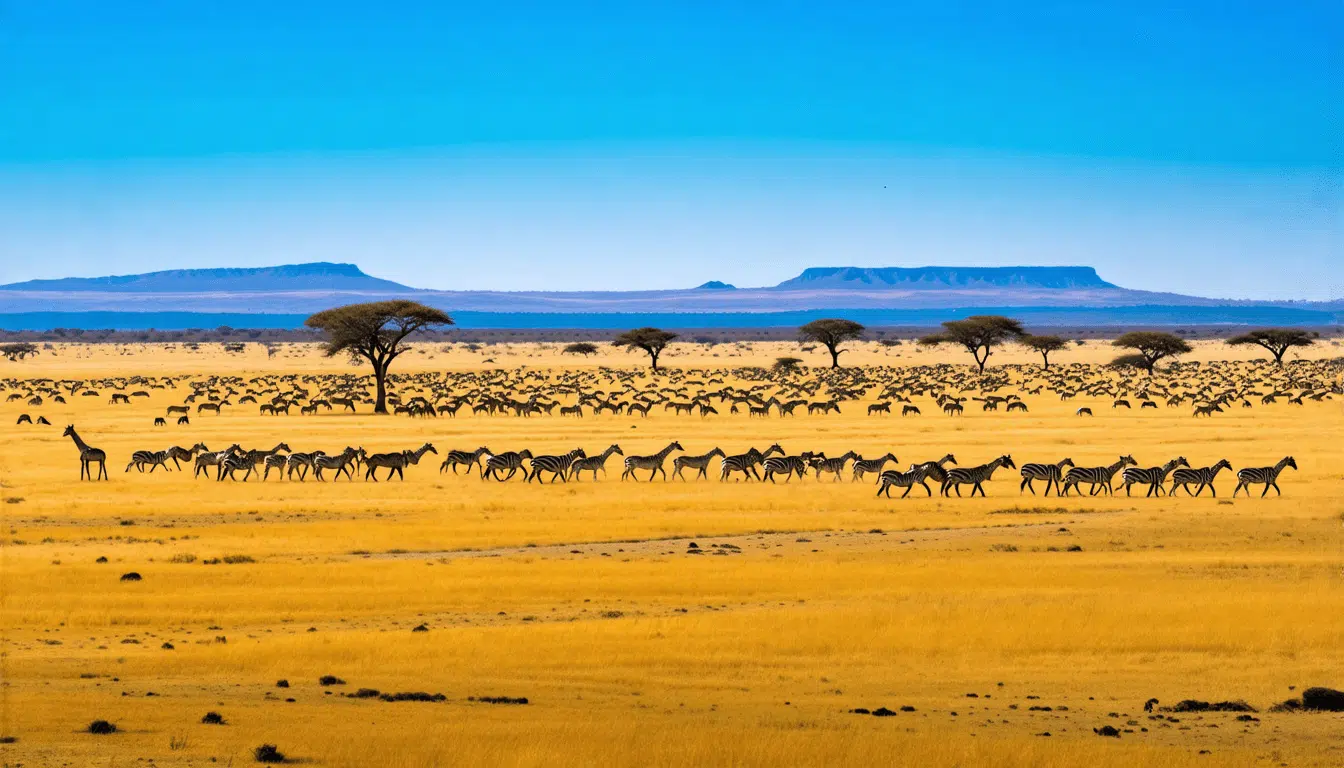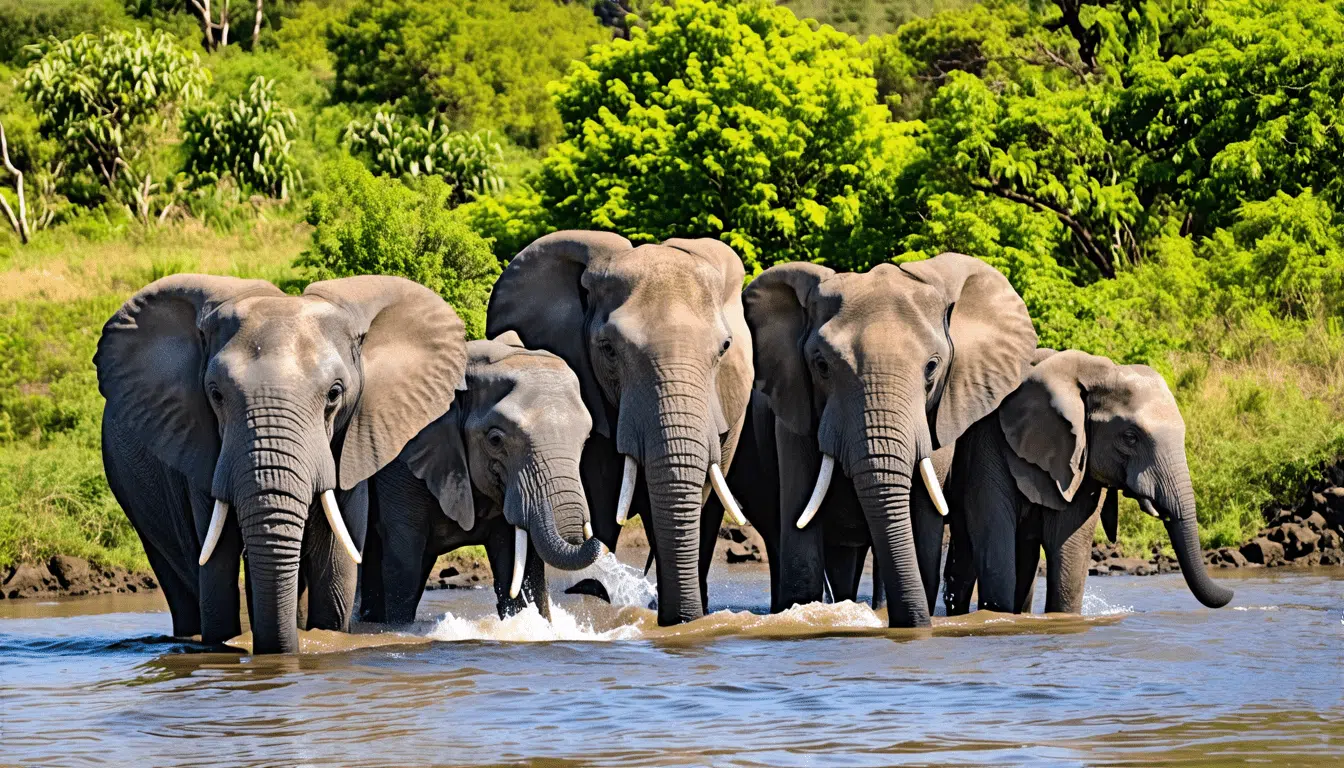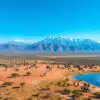Seeing Gentle Giants: A Journey into Elephant Tourism in East Africa
Ever dreamed of seeing elephants roam freely in their natural habitat, feeling a sense of awe as these incredible animals graze, play, and live in the vast plains of East Africa? Well, you’re not alone. East Africa has an almost magnetic pull on those of us who yearn for wild, unfiltered experiences and an authentic connection with nature. There’s something uniquely enchanting about elephants, isn’t there? They’re not just the largest land animals on Earth; they’re also key players in maintaining their ecosystems.
Imagine, if you will, a land where elephants walk with the grace of royalty, shaping the landscape as they wander, creating paths through dense forests and spreading seeds that grow into the next generation of trees. Elephants help maintain the delicate balance of the African savanna. But like many of nature’s wonders, they face threats from habitat loss and poaching. This is where tourism, especially responsible tourism, steps in as a hero in disguise. By choosing to visit East Africa’s national parks and reserves, tourists like you and me can play a role in preserving these magnificent creatures for generations to come.
Why is East Africa so renowned when it comes to elephant tourism, you ask? It’s a combination of its dramatic landscapes, rich biodiversity, and the once-in-a-lifetime opportunity to witness wildlife spectacles like the Great Migration. Every year, thousands of safari enthusiasts flock here, drawn by the promise of watching elephants against a backdrop of Mount Kilimanjaro or witnessing a whole family of these gentle giants march across the Serengeti. It’s as if East Africa were crafted by nature specifically for wildlife lovers.
In this article, we’ll dive into some of the top spots to see elephants in East Africa, offer tips on when and how to visit for the best viewing experiences, and discuss the critical conservation efforts aimed at protecting these beloved creatures. Whether you’re planning your first safari or considering a return to the savannas, read on to discover how you can indulge in the awe of elephant sightings while contributing meaningfully to their conservation. Let’s explore this remarkable corner of the world, one elephant at a time.
Introduction to Elephant Tourism in East Africa
The Significance of Elephants in East Africa’s Ecosystem
When we think of East Africa, the image of majestic elephants often springs to mind, strolling through vast savannas under the blazing sun. But have you ever paused to consider why elephants are such a big deal in this region? Elephants play an essential role in maintaining the delicate balance of East Africa’s ecosystems. By acting as nature’s bulldozers, they create paths in dense forests, which help other animals navigate through their environment. They also aid in seed dispersal, fostering plant diversity, which in turn supports a variety of wildlife. Simply put, without these gentle giants, East Africa’s mesmerizing wildlife tapestry could unravel.
But here’s the catch: elephants are vulnerable. Their majestic tusks make them a target for poachers, and their expansive habitats are shrinking as human settlements grow. So, how do we strike a balance? How can we ensure these magnificent creatures continue to roam the wild for generations to come? Enter conservation and tourism, an unexpected dynamic duo.
The Role of Tourism in Elephant Conservation
Let’s face it, when it comes to conservation, money talks. Supporting elephant populations—whether through anti-poaching efforts, habitat restoration, or community outreach—demands resources. And this is where you, the enthusiastic traveler, step in. Tourism is not just about snapping photos and ticking off bucket lists; it’s a critical funding source for conservation initiatives.
Imagine this: You’re gliding through the African savanna on a jeep, a herd of elephants ambling peacefully beside you. By choosing reputable safari operators committed to conservation, your trip helps finance protective measures and engage local communities in elephant-friendly practices. It’s like being a hero on vacation, right? Every tourist dollar spent can contribute to elephant preservation, ensuring these creatures thrive rather than just survive.
A Renowned Destination for Unparalleled Wildlife Experiences
East Africa is no ordinary tourist spot. Safari enthusiasts worldwide are drawn to this cradle of humanity for its stunning landscapes and wildlife spectacles, like the iconic Great Migration. Picture massive herds of wildebeest, zebras, and antelopes crossing rivers, pursued by predators lurking at the water’s edge. It’s a National Geographic documentary come to life! But amidst these extraordinary scenes, elephants stand out, their graceful presence adding a serene majesty to the chaotic dance of survival.
Sure, you might be thinking, I’ve seen elephants in zoos. Why travel all the way to East Africa? But have you ever locked eyes with an elephant under a fiery African sunset, the distant rumble of lion roars echoing through the plains? Trust me, no zoning laws or artificial enclosures can capture the essence of witnessing these creatures in their natural realms. Plus, who can resist the chance to brag about being just a stone’s throw away from an elephant clan while marveling at Mount Kilimanjaro or the stunning Serengeti skies?
So, when you’re pondering your next great adventure, consider how your wanderlust can contribute to global conservation efforts. And in the spirit of protecting our planet’s precious wildlife, let’s explore how to enjoy these incredible, elephant-filled vistas responsibly. Ready to make a difference while filling your senses with unforgettable sights? Grab your binoculars and safari hat—it’s time to dive deeper into the world of elephant tourism in East Africa!
Must-Visit National Parks and Reserves
Serengeti National Park, Tanzania
Ah, the Serengeti! Just saying the name invites images of sweeping savannas and endless horizons. Have you ever wondered what it feels like to witness the Great Migration? Imagine thousands of wildebeest and zebra moving in concert, and nestled among them, the majestic elephants, dignified as ever. In the Serengeti, during the migration, elephant sightings are not just happenstance—it’s like they’re part of the parade. While many come for the migration madness, staying a bit longer can reward you with elephant encounters you’ll remember for a lifetime. They tend to gather near rivers and waterholes to drink and bathe, and occasionally, they’ll display their playful side, tossing mud with those incredible trunks!
Amboseli National Park, Kenya
Picture this: elephants marching confidently across a vast plain with the mighty Mount Kilimanjaro as their backdrop. That’s Amboseli for you. Honestly, the first time I saw this sight, my jaw dropped. It’s almost mythical—like a scene straight out of a dream. As one of Kenya’s most famous parks, Amboseli offers a front-row seat to the impressive social structures of elephant herds. You’ll often see them in close-knit family units, teaching us a thing or two about loyalty and community (side note: we could all take a page out of their book). The contrast of these gentle giants against the towering mountain is nothing short of spectacular, making Amboseli a must-visit for anyone eager to see elephants in their natural grandeur.
Tarangire National Park, Tanzania
Let me let you in on a not-so-secret secret—Tarangire is elephant central! I mean, we’re talking about some of the highest elephant concentrations in Tanzania. Expect to see large herds using the park as their stomping ground, particularly during the dry season when they gather near the Tarangire River. Here’s a little tip: be sure to carry your camera; you’ll find elephants here against the backdrop of iconic baobabs and termite mounds, lending your photos an extra touch of authenticity. And if you find elephant behavior fascinating (as you should!), then Tarangire offers a ringside seat to watch these magnificent creatures interact, play, and just own the space they inhabit.
Tsavo National Parks, Kenya
Now let’s talk about raw, untamed wilderness—welcome to Tsavo! Tsavo’s huge ecosystem is split into Tsavo East and Tsavo West, and together they form one of the largest national parks in the world. This place is massive! It’s a sanctuary where elephants have the space and freedom to roam far and wide. Their dusty red coats, a peculiar result of dust baths in the park’s red soil, often surprise first-time visitors (and let’s face it, make them appear extra photogenic). Tsavo plays a crucial role in elephant conservation, offering a natural corridor and a safe haven for these gentle creatures. Whether you’re in awe of their size or their familial interactions, Tsavo provides a backdrop that feels otherworldly, highlighting just how significant and special these mammals really are.
So, whether you’re witnessing the stirring scenes in Serengeti, the inspiring sights of Amboseli, the bustling herds in Tarangire, or the sweeping landscapes of Tsavo, the elephants of East Africa offer an experience that’s both heart-stirring and humbling. These parks and reserves not only give us a glance into the fascinating life of elephants but also emphasize the importance of conserving these vital ecosystems. Have you started packing yet?
Best Times and Tours for Elephant Watching
Have you ever been caught in a situation where you arrive at a destination only to realize you’ve missed the prime time to see what you came for? Trust me, it feels a bit like showing up to a concert after the main act has left the stage. If you’re planning on visiting East Africa to marvel at the majestic elephants, timing is everything. Knowing when and where to go is key to having an unforgettable experience.
Seasonal Variations: When to Visit
First things first, let’s tackle the matter of seasons. East Africa, with its tantalizing mix of landscapes and climates, doesn’t exactly follow the typical summer-winter cycle many are used to. Instead, it swings between dry and rainy seasons. For elephant enthusiasts, the dry season, which generally runs from late June to October, is your golden ticket.
Why the dry season, you ask? It’s when animals, including elephants, converge at waterholes, making them easier to spot. Picture this: during the dry spell in Amboseli National Park, the elephants often parade across the dusty plains with the glorious Mount Kilimanjaro looming in the background. It’s as if nature conjured the setting for a perfect postcard.
Conversely, the wet season, lasting from November to May, might play hard to get when it comes to animal sightings. However, the landscapes burst into vibrant greens and it’s off-peak, meaning fewer tourists and potentially lower costs. If you’re a fan of lush scenery and don’t mind a little challenge in tracking down the elephants, this is your time.
Guided Tours and Safari Packages
Now, how about we navigate through the often-bewildering world of tours and safari packages? Guided tours are usually the go-to option and for good reason. They offer a curated experience, steering you clear of unnecessary detours – which, believe me, can be as annoying as a GPS leading you to a dead-end street.
If you’re on a budget, group tours might be your best friend. Sharing the safari vehicle with fellow adventurers can save you a pretty penny while allowing you to make new friends. Who knows, you might bond over the awe of watching a herd of elephants graze peacefully right in front of you. Sounds like a travel tale you’d want to be a part of, right?
For those who prefer a more intimate adventure – maybe you’re celebrating an anniversary or just enjoy your own space (I get it) – private tours are an available splurge. They offer flexibility, allowing you to wander at your own pace and focus on what most captivates you. Just make sure to opt for tour operators that emphasize ethical and sustainable practices, supporting conservation efforts while your heart skips a beat at the sight of these giant creatures.
Getting Up Close: Tips for Ethical Encounters
Alright, let’s chat about the part everyone gets excited for: getting up close and personal with elephants. It’s one thing spotting them from afar, grazing or gathering near a mud pool, but it’s another experience entirely to have that closer interaction while respecting their space.
First up, always follow your guide’s instructions. They are the experts, understanding the dos and don’ts better than anyone else. Remember, these are wild animals, and the safari is their home, not ours. Approaching them too closely or making sudden movements is akin to someone barging into your living room uninvited – it’s not cool.
Keep your camera ready but practice some restraint. It’s easy to get lost in capturing the moment (literally) through a lens, but make sure to take a step back and simply enjoy the scene as it unfolds in real life. Trust me, the memory will last just as long, if not longer.
Lastly, consider nighttime visits if your itinerary, budget, and bravery allow. Some parks offer night safaris, providing a different perspective. The air cools down, and the chances of witnessing crepuscular behavior – when elephants are more relaxed and active – increase. Plus, there’s something undeniably thrilling about the African night, isn’t there?
East Africa is ready to present you with a symphony of nature, with elephants playing a compelling lead role. If you play your cards right and plan with these tips in mind, you’ll walk away not just with photos but unforgettable stories worthy of sharing around every campfire.
Conservation Efforts and Responsible Tourism
Overview of Current Conservation Initiatives
When it comes to conservation, East Africa is making tremendous strides to protect its majestic elephant populations. Have you ever thought about the people on the ground working tirelessly to safeguard these gentle giants? Organizations like the Amboseli Trust for Elephants and Save the Elephants are pivotal players in the region, focusing on research, anti-poaching efforts, and community education.
For instance, in Kenya, the David Sheldrick Wildlife Trust not only rescues and rehabilitates orphaned elephants but also incorporates community awareness programs to reduce human-elephant conflict. In Tanzania, the Ruaha Carnivore Project works alongside local villagers to promote coexistence between humans and wildlife by coming up with creative solutions like chili bombs—yes, you read that right—as a deterrent for elephants raiding crops. These initiatives demonstrate how collaboration and innovation are crucial to elephant preservation.
How Tourists Can Contribute to Conservation Efforts
You might be wondering how your safari adventure can actually make a difference. The answer lies in choosing to be a responsible tourist. One straightforward way is by supporting eco-friendly accommodations. Many lodges and camps are designed with sustainability in mind, employing solar energy and participating in local conservation projects. Take a moment to research and opt for those that prioritize the environment and community.
Furthermore, your choice of safari operator can significantly impact conservation. Look for companies that are transparent about their contributions to wildlife protection, perhaps through financial support to conservation projects or partnerships with local communities. In doing so, you’re also supporting the ongoing efforts to combat poaching and illegal wildlife trade, an issue that continues to threaten elephant populations.
Impact of Responsible Tourism on Local Communities and Wildlife Preservation
Here’s a question: when you embark on an elephant-spotting safari, who else benefits from your adventure? The answer is the local communities that live around these magnificent national parks. Responsible tourism creates jobs, boosts the local economy, and fosters a sense of pride and ownership among community members. For example, guides, porters, and artisans around the Serengeti or Amboseli rely heavily on tourism for their livelihoods, transforming your vacation into an act of empowerment.
In turn, these communities become stewards of the environment, often actively participating in conservation initiatives. It’s a win-win scenario: you get to experience elephants in the wild, and the funds generated help secure their habitats and the cultural heritage of the people who call East Africa home.
At the end of the day, responsible tourism isn’t just about minimizing your ecological footprint; it’s about enriching the lives of everyone involved—humans and elephants alike. So next time you find yourself in the midst of an elephant herd, remember that your experience is part of a larger story of conservation and community, one that you are an essential part of. Isn’t it gratifying to know that your travel choices can have such a profound and positive impact?
As we wrap up this journey through East Africa’s elephant paradises, it’s clear that these majestic creatures are not just a tourist attraction—they’re a vital part of the region’s identity and ecosystem. Think about the moments when you can witness a herd thunder across the Serengeti during the Great Migration or catch a glimpse of the mighty tuskers against the iconic backdrop of Mount Kilimanjaro in Amboseli. These are not just travel goals; they’re experiences that connect us to something larger than ourselves.
But let’s not forget, our role goes beyond being mere spectators. We are participants in these ecosystems, and our choices matter. Have you ever wondered how your safari dollars are spent? By opting for tours that prioritize ethical and sustainable practices, you’re supporting local conservation efforts. You’re helping keep poaching at bay and ensuring that these gentle giants roam free for generations to come.
East Africa offers some of the best wildlife encounters imaginable, and traveling during the right season can make all the difference. Imagine watching Tarangire’s elephants quench their thirst at the river during the dry season, or feeling a part of the vast wilderness of Tsavo—a temporary home to one of the continent’s largest elephant populations.
And while it’s a thrill to get up close to these giants, let’s be mindful. Those tips about maintaining a respectful distance and sticking to designated paths aren’t just suggestions—they’re essential to preserving the fragile balance of these habitats.
When we choose responsibly, we contribute not just to the preservation of elephant populations but also to the enhancement of local communities. It’s about more than just the thrill of seeing these magnificent creatures. It’s about ensuring that the children of today, and those who come tomorrow, can also revel in the same awe-inspiring experiences.
So, as you pack your bags for that dream East African adventure, remember that you’re part of a bigger picture. Let’s travel with purpose, leaving behind footprints of change and ensuring that East Africa remains a beacon of biodiversity and natural splendor. Ready to make some unforgettable memories?






